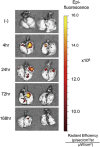Adipose stem cell-derived nanovesicles inhibit emphysema primarily via an FGF2-dependent pathway
- PMID: 28082743
- PMCID: PMC5291836
- DOI: 10.1038/emm.2016.127
Adipose stem cell-derived nanovesicles inhibit emphysema primarily via an FGF2-dependent pathway
Abstract
Cell therapy using stem cells has produced therapeutic benefits in animal models of COPD. Secretory mediators are proposed as one mechanism for stem cell effects because very few stem cells engraft after injection into recipient animals. Recently, nanovesicles that overcome the disadvantages of natural exosomes have been generated artificially from cells. We generated artificial nanovesicles from adipose-derived stem cells (ASCs) using sequential penetration through polycarbonate membranes. ASC-derived artificial nanovesicles displayed a 100 nm-sized spherical shape similar to ASC-derived natural exosomes and expressed both exosomal and stem cell markers. The proliferation rate of lung epithelial cells was increased in cells treated with ASC-derived artificial nanovesicles compared with cells treated with ASC-derived natural exosomes. The lower dose of ASC-derived artificial nanovesicles had similar regenerative capacity compared with a higher dose of ASCs and ASC-derived natural exosomes. In addition, FGF2 levels in the lungs of mice treated with ASC-derived artificial nanovesicles were increased. The uptake of ASC-derived artificial nanovesicles was inhibited by heparin, which is a competitive inhibitor of heparan sulfate proteoglycan that is associated with FGF2 signaling. Taken together, the data indicate that lower doses of ASC-derived artificial nanovesicles may have beneficial effects similar to higher doses of ASCs or ASC-derived natural exosomes in an animal model with emphysema, suggesting that artificial nanovesicles may have economic advantages that warrant future clinical studies.
Figures






Similar articles
-
Adipose stem cell crosstalk with chemo-residual breast cancer cells: implications for tumor recurrence.Breast Cancer Res Treat. 2019 Apr;174(2):413-422. doi: 10.1007/s10549-018-05103-w. Epub 2018 Dec 29. Breast Cancer Res Treat. 2019. PMID: 30594967 Free PMC article.
-
Hypoxia Enhances Proliferation of Human Adipose-Derived Stem Cells via HIF-1ɑ Activation.PLoS One. 2015 Oct 14;10(10):e0139890. doi: 10.1371/journal.pone.0139890. eCollection 2015. PLoS One. 2015. PMID: 26465938 Free PMC article.
-
Priming Adipose Stem Cells with Tumor Necrosis Factor-Alpha Preconditioning Potentiates Their Exosome Efficacy for Bone Regeneration.Tissue Eng Part A. 2017 Nov;23(21-22):1212-1220. doi: 10.1089/ten.tea.2016.0548. Epub 2017 Mar 23. Tissue Eng Part A. 2017. PMID: 28346798
-
Adipose-Derived Stem Cells Secretome and Its Potential Application in "Stem Cell-Free Therapy".Biomolecules. 2021 Jun 13;11(6):878. doi: 10.3390/biom11060878. Biomolecules. 2021. PMID: 34199330 Free PMC article. Review.
-
Hair regeneration using adipose-derived stem cells.Histol Histopathol. 2016 Mar;31(3):249-56. doi: 10.14670/HH-11-686. Epub 2015 Nov 3. Histol Histopathol. 2016. PMID: 26536569 Review.
Cited by
-
MicroRNA-155 mediates multiple gene regulations pertinent to the role of human adipose-derived mesenchymal stem cells in skin regeneration.Front Bioeng Biotechnol. 2024 Mar 18;12:1328504. doi: 10.3389/fbioe.2024.1328504. eCollection 2024. Front Bioeng Biotechnol. 2024. PMID: 38562669 Free PMC article.
-
Biofabrication of nanovesicles for brain diseases.Neural Regen Res. 2023 Mar;18(3):525-526. doi: 10.4103/1673-5374.346473. Neural Regen Res. 2023. PMID: 36018160 Free PMC article. No abstract available.
-
Mesenchymal stromal cell-derived nanovesicles ameliorate bacterial outer membrane vesicle-induced sepsis via IL-10.Stem Cell Res Ther. 2019 Aug 1;10(1):231. doi: 10.1186/s13287-019-1352-4. Stem Cell Res Ther. 2019. PMID: 31370884 Free PMC article.
-
Physical modulation of mesenchymal stem cell exosomes: A new perspective for regenerative medicine.Cell Prolif. 2024 Aug;57(8):e13630. doi: 10.1111/cpr.13630. Epub 2024 Mar 10. Cell Prolif. 2024. PMID: 38462759 Free PMC article. Review.
-
Extracellular vesicles: novel communicators in lung diseases.Respir Res. 2020 Jul 8;21(1):175. doi: 10.1186/s12931-020-01423-y. Respir Res. 2020. PMID: 32641036 Free PMC article. Review.
References
-
- Pauwels RA, Rabe KF. Burden and clinical features of chronic obstructive pulmonary disease (COPD). Lancet 2004; 364: 613–620. - PubMed
-
- Huh JW, Kim SY, Lee JH, Lee JS, Van Ta Q, Kim M et al. Bone marrow cells repair cigarette smoke-induced emphysema in rats. Am J Physiol Lung Cell Mol Physiol 2011; 301: L255–L266. - PubMed
Publication types
MeSH terms
Substances
LinkOut - more resources
Full Text Sources
Other Literature Sources
Medical
Miscellaneous

